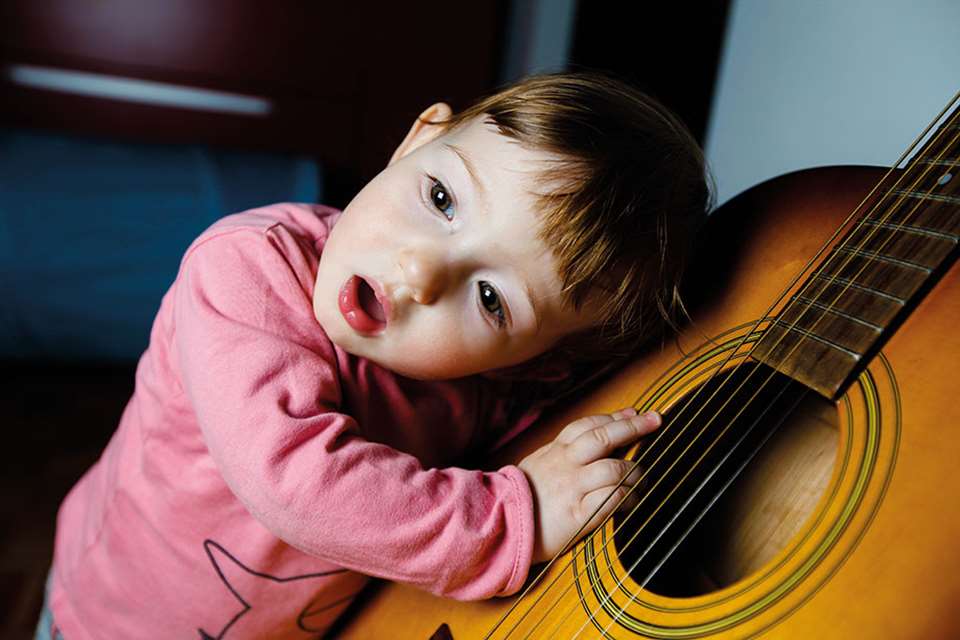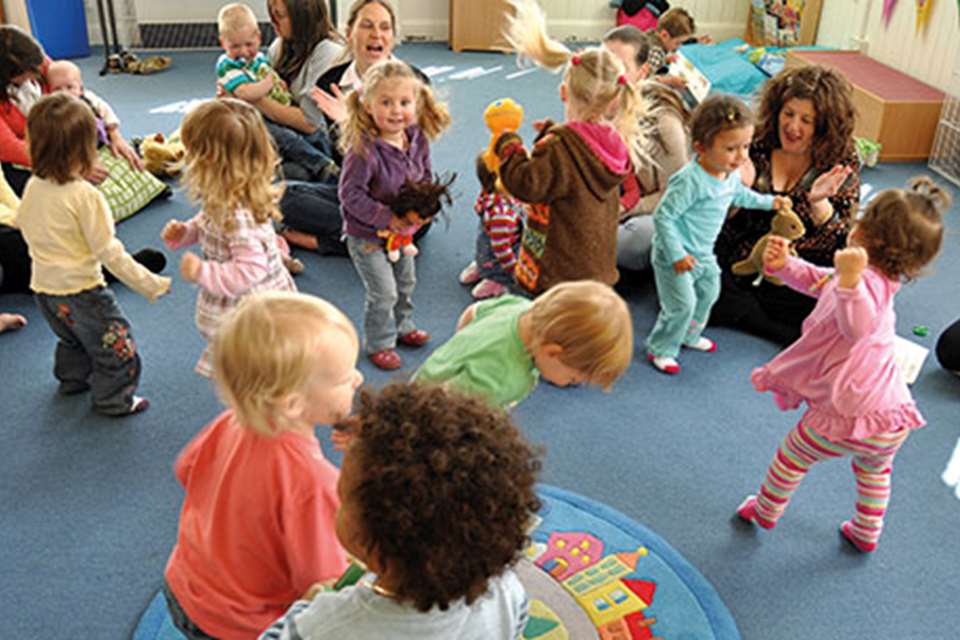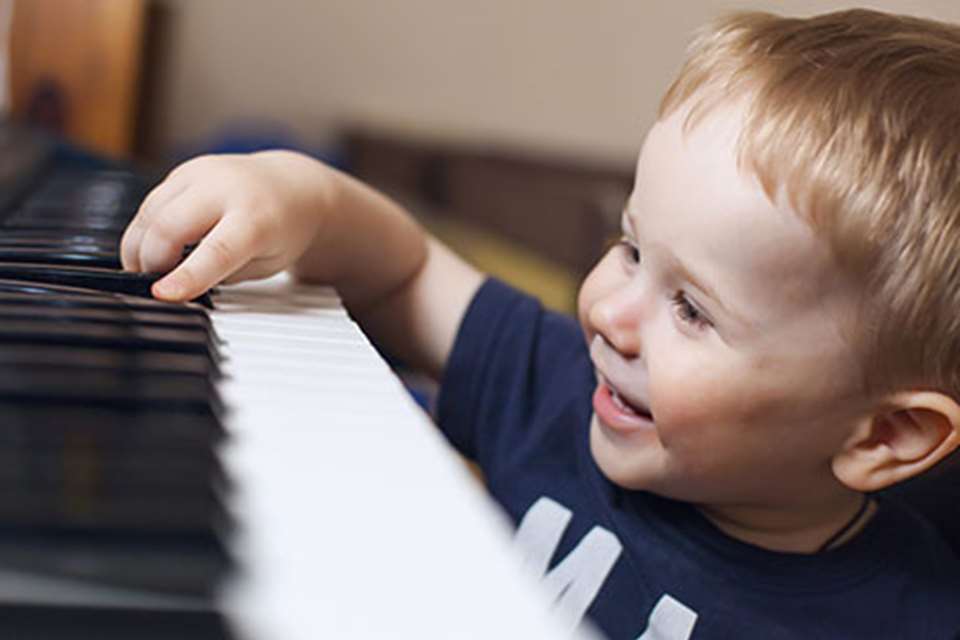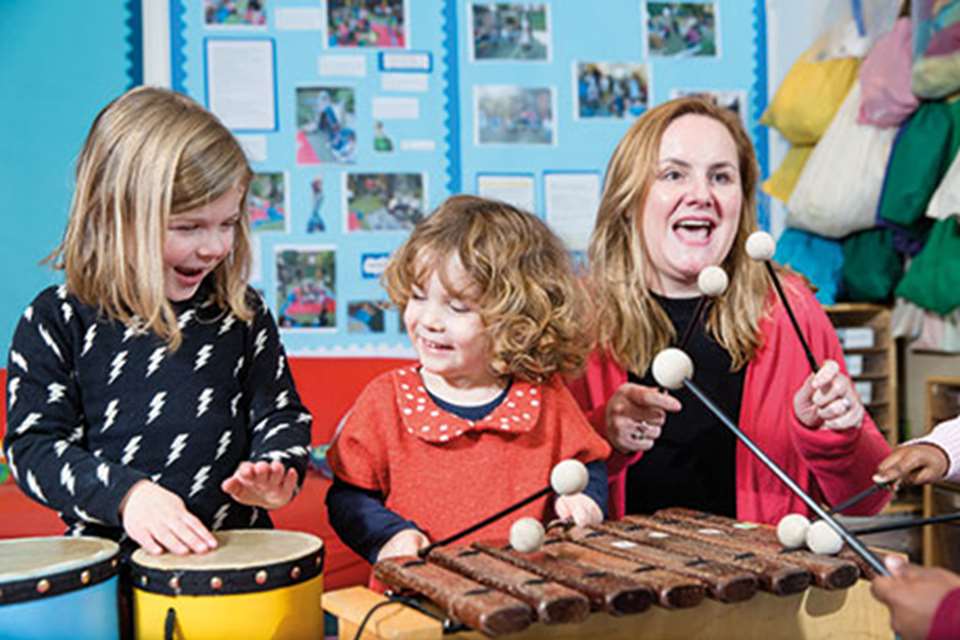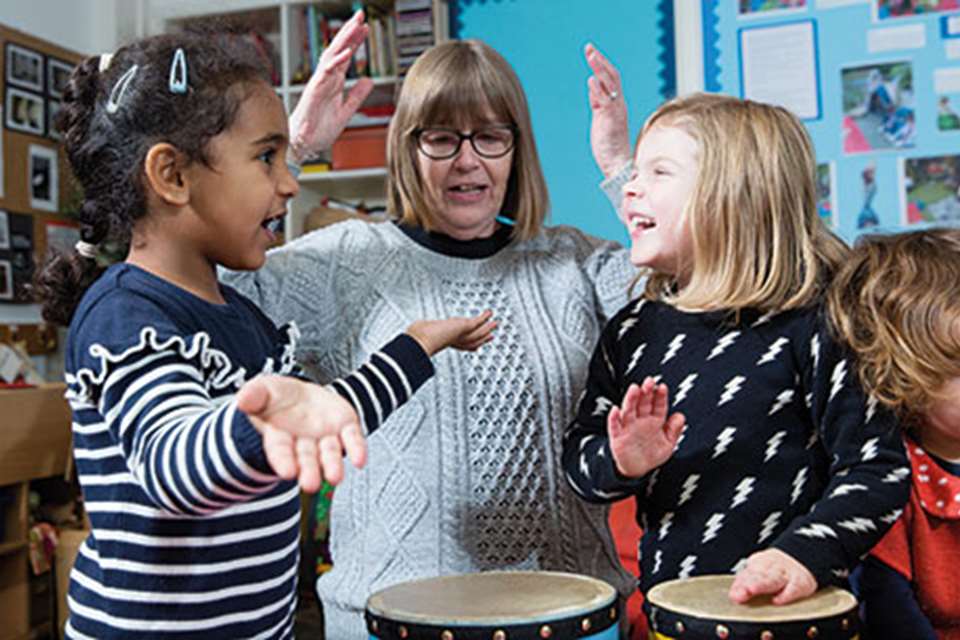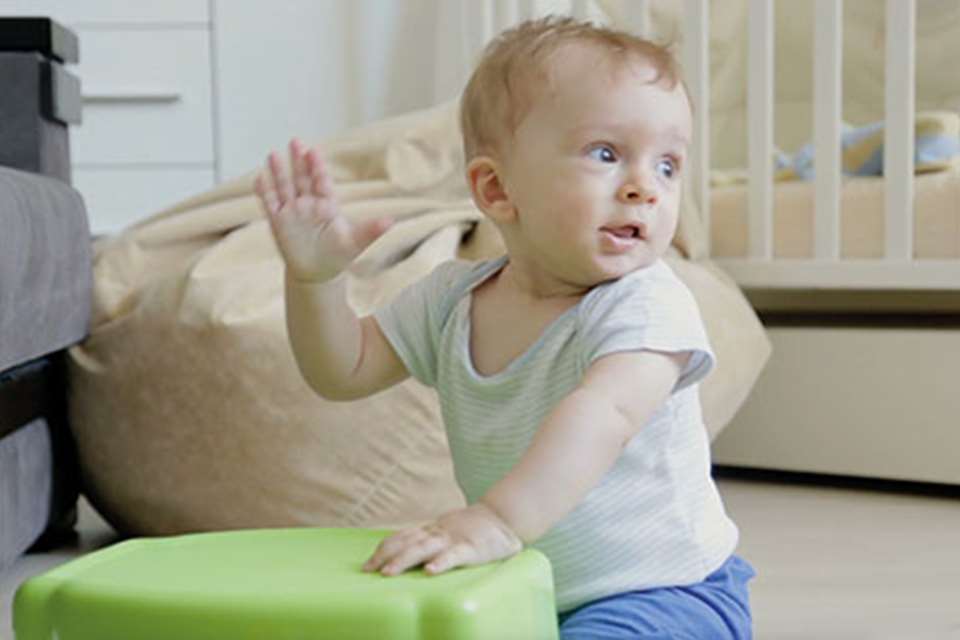Learning & Development: Music: Part 7 - Far and wide
Linda Pound
Monday, March 19, 2018
Use music and instruments from around the globe to help children understand the world, says Linda Pound
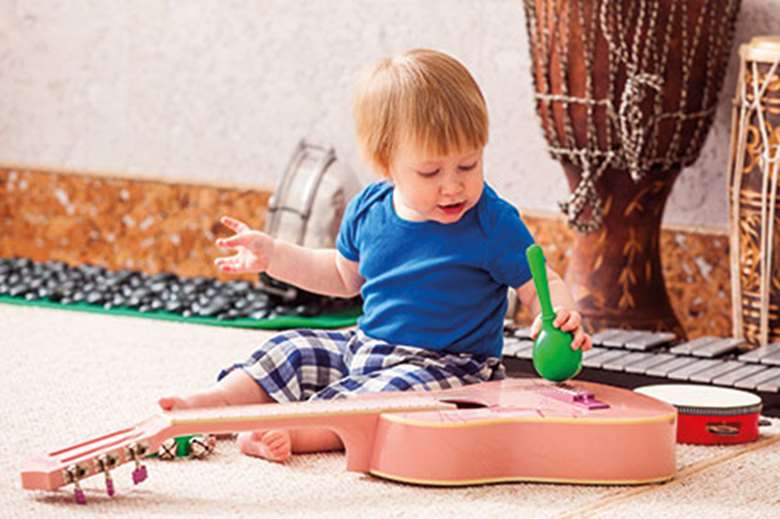
Download the PDF of this article
Throughout this series it has become increasingly clear that musical behaviour is a fundamental element of human activity. It is closely linked to the development of mathematical and linguistic understanding and thinking, but it is also key to our personal relationships, to our communication, and to our emotional well-being. This remains true from our earliest days, with baby songs and dances, adult-directed talk, right through adulthood and into old age. So, of course, the immense power of music can be harnessed to help young children to better understand their worlds.
PEOPLE AND COMMUNITIES
One of the prime functions of music is in creating a sense of community. This occurs in the use of music within religions, clubs or societies. Every football team’s supporters have favourite songs. Schools have school songs, and in the early years we make particular use of this phenomenon by using song to gather children together. Whenever we want to form a group of young children, it is very likely that we will begin by singing.
Time and place
The relationship between music and memory begins early. If 15-month-old Isabel heard her favourite lullaby at any time of day, she would begin to get ready for a bath – associating the tune with her bedtime rituals.
The memories triggered for adults by particular pieces of music can be used to give young children a sense of time and place. For example, an awareness of parents’ favourite music or songs, or grandparents’ favourite dances, can support children in developing that very difficult concept of time. If you live and work in a diverse community, it can also give a sense of place. Perhaps you could collect lullabies from around the world, or maybe birthday songs, nursery rhymes and counting songs.
Cultures
If you live in a monocultural or less diverse community, you will need to work harder at introducing children to a wide variety of cultural styles of music (see box, right).
Young children are just beginning to understand that their experience and understandings of the world may differ from those of other children. Discussing similarities and differences is key to helping children gain a clear perspective of the worlds around them. Vivian Gussin Paley, writing in White Teacher, argues that if adults fail to talk about differences ‘spontaneously, casually, naturally and uncritically’, children may begin to feel that differences such as skin colour, religious beliefs or cultural traditions are taboo subjects. This in turn can make children anxious and may hinder their learning.
Celebrations
Music provides an easy way for children to gain insight into festivals of all sorts from around the world, providing great opportunities to explore musical traditions through song and dance. Best of all, if you can, enlist the help of a staff member, parent or community member who has first-hand experience of a Diwali celebration or Chinese New Year. If you’re not so lucky, song books, DVDs and recordings can offer some great ideas.
THE WORLD AROUND US
In the second article in this series, on physical development, many experiences which support children’s understanding of the world around them were highlighted. Understanding of location and environment begins very early, and apparently mundane everyday actions contribute to children’s knowledge of the world. But simple beginnings such as crawling and rolling are vital to later conceptual development.
Vestibular and proprioceptive systems
Babies begin to develop a sense of balance and spatial orientation through stimulation of the vestibular system. This occurs in all those games that babies and toddlers love to play which involve rocking, hanging upside down, being tossed in the air or spun around. These are frequently accompanied by songs or rhythmic rhymes and movement.
Understanding of location and environment also involves gaining a sense of proprioception. This has been described as bubble space or body space. In other words, children need rich experiences which give them a sense of the space that their bodies occupy when stretched out, curled up, arms extended, flat on the ground or from a high point.
This sense is further enhanced as they become increasingly mobile. Their growing sense of the space around them includes awareness of the room available as they dance under an arch made by other children or the leeway needed to spin a hoop in time to music. In their rhythmic movement, children can be encouraged to explore horizontal, vertical, circular, diagonal and zig-zag movements – all of which will contribute to their understanding of the world around them.
In order to promote varied movements, try out some of the musical excerpts and suggested dances in the two books by Helen MacGregor suggested overleaf (see More information). If you lack confidence or knowledge in finding the wide variety of musical styles and genres, these are an excellent starting point.
Experiences and horizons
Having started by making the body’s space and capabilities familiar, study of the world extends to include less familiar environments. As children’s experiences and horizons are broadened, perhaps by visiting the local supermarket or tyre shop, by nurturing hens’ eggs and watching them hatch, by collecting autumn leaves or watching a baby being bathed, songs and rhymes can help children reflect on what they have seen and heard.
These may be well-known songs or they may be improvised versions. For example, a group of children fascinated by minibeasts focused on Ruth Brown’s Snail Trail and made up a song which they sang to the tune of ‘London Bridge is falling down’. The first line was ‘Slimey snail leaves a trail’ and subsequent verses identified where he had left a trail. Slimey snail went under the table, over the chair, up to the ceiling – and so on!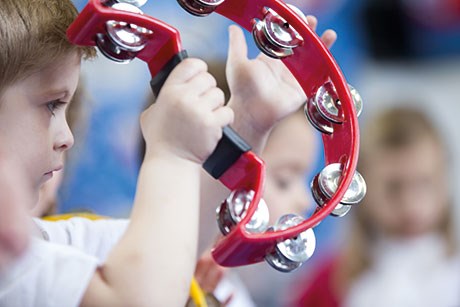
Singing and moving
Knowledge of the world may also be enhanced by singing about and moving in a similar fashion to various animals, weather or people. If you don’t know, or can’t find a suitable song or rhyme, just make one up. Music’s function as a memory tool can reinforce understanding of animals and plants, seasons and machines.
Many of the ideas outlined in the second article in this series, on music and physical development, will also support understanding of the world in other ways. Instruments using different materials such as wood, skin and metal will produce different sound qualities. Similarly, instruments played in different ways (plucked, blown, scraped, beaten or shaken) can give children scientific insight into the different ways that sound is produced.
Imitating sounds
These explorations can be made more focused by encouraging children to find ways to make sounds that imitate noises they hear in the environment. Which instruments or other soundmakers can produce the sound of a dishwasher, a bus, a horse trotting, or a pneumatic drill? Alternatively, can the sound produced by a broom or water in the water tray be turned into a piece of music? Or sound effects created for favourite stories such as Bear Huntor Peace at Last?
Encouraging children to create sounds that are scary or exciting also promotes curiosity and experimentation – and plenty of discussion.
TECHNOLOGY
Don’t forget that technology is not confined to electronic media. Steiner practitioners who choose not to offer access to electronic devices refer in their curriculum documents to ‘warm technology’. A very simple example of exploring technology in this way can be offered by considering rainsticks.
These are generally made from a cactus stem – the prickles are hammered in and this results in an uneven pathway for seeds inside to move along the length of the rainstick. Clear plastic rainsticks allow children to see how the sound is made. Making a rainstick by pushing small sticks into a cardboard tube gives children another understanding of why the sound is as it is. Changes discussed might include ways in which the sound varies if more or fewer sticks are used.
Recorded music
There are a number of ways in which recorded music may be accessed by children and this means that a wide range of types and styles of music are readily available. However, it is also important to given children experiences which allow them to see how things work.
The use of recording equipment was discussed in Part 2 of this series (‘Move it!’, 14 October 2017) and this, of course, offers children a particular kind of technological experience. There are any number of software packages aimed at teaching young children about music (see, for example, www.commonsensemedia.org/blog/14-music-apps-games-and-websites-to-help-kids-compose-learn-and-discover#), but they should be used with caution. Although they are entertaining, they cannot replace the physical experience that comes from real singing, dancing and playing.
MUSIC FROM AROUND THE WORLD
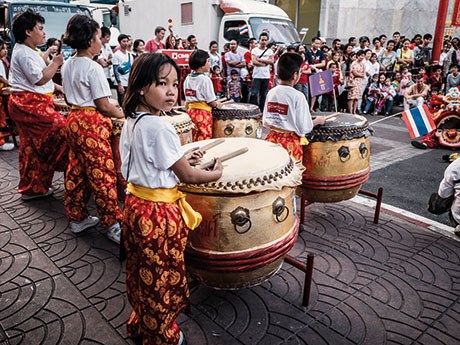
Retailers talk glibly about world music as though it were a single entity distinct only from Western pop or classical music, but around the world there are many kinds of music and dance. In every corner of the globe, pop music, traditional music, music for festivals and worship, music for children, and work music can be found.
Young children often have a relatively narrow experience of music. They have, after all, not been alive for very long. It is easy for them to become so familiar with a particular genre that they do not feel comfortable with anything else. The aim of education in general must be to broaden children’s horizons. By introducing them to a wide variety of musical styles and traditions we will be educating children both musically and in terms of their understanding of the world – creating more tolerant and flexible learners.
In order to offer a wide musical experience which will enhance children’s knowledge and understanding of the world:
- start from something familiar. If children are used to upbeat music, then choose some pieces from alternative traditions with a similar tempo. If their favo
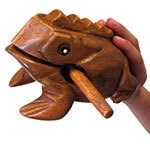 urite instruments are drums or guitars, choose some recorded music which features drumming. In addition to guitar music you could try introducing music from some other stringed instruments such as a double bass or a violin played pizzicato.
urite instruments are drums or guitars, choose some recorded music which features drumming. In addition to guitar music you could try introducing music from some other stringed instruments such as a double bass or a violin played pizzicato. - include in your collection of instruments items from different cultures. There are many types of drum, for example – some made from clay or wood with skin stretched over the top. Encourage children to experiment with different kinds of beaters, including hands. Güiros
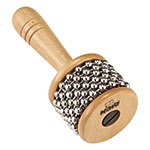 and cabasas are less fragile than violins as examples of instruments that are played by scraping. Most cultures have a wide variety of instruments that are shaken. Those that are plucked such as mandolins and harps may be very fragile, but thumb pianos or mbiras are often more robust.
and cabasas are less fragile than violins as examples of instruments that are played by scraping. Most cultures have a wide variety of instruments that are shaken. Those that are plucked such as mandolins and harps may be very fragile, but thumb pianos or mbiras are often more robust. - don’t forget that some instruments are blown not by breath from the mouth but by the air pushed through by hands. There is, for example, a Vietnamese instrument consisting of bamboo tubes mounted horizontally which is play by cupped hands clapping across the circular ends of the tubes. Or closer to home and perhaps more familiar, all sorts of squeeze boxes – such as concertinas, melodeons and accordions – are also played by air being blown through pipes.
- explore recorded music and DVDs featuring music and dance from around the world. Stomp, for example, feature a range of styles and instruments in their DVD Rhythms of the World. Many of the tracks are very short and very stimulating, enabling children to engage fully in new experiences.
HOME-MADE INSTRUMENTS: GOOD OR BAD?
There are purists in the world of music who would argue that children should have only real, properly tuned instruments for fear of damaging their sense of pitch. Similarly, some people would suggest that instruments should only be played in one ‘right’ way.
While it is true that children should be encouraged to listen carefully to sounds that they are making and taught to treat instruments with respect, that does not mean that only proper instruments played ‘properly’ should be offered to children, or that there is only one right way to play them. Home-made instruments provide children with rich experiences:
Instruments that are designed to be plucked or scraped are often very fragile. Home-made versions made with elastic bands or combs scraped on corrugated card will never replace the real thing but they do offer insight into how sounds can be made in a variety of ways.
Children enjoy making and playing shakers. In using different types of containers (card, tin, plastic) and materials for shaking such as rice, sand or pebbles, very different sounds may be produced.
Since less care is needed when playing with home-made instruments, children can use such sound-makers, which can be readily replaced if damaged, as part of their imaginative play.
Encouraging children to explore sound in the environment supports the growth of curiosity, recognising that the world of sound is all around us and not confined to formal musical instruments.
Scientific exploration includes the sounds that different materials and objects make – all part of understanding children’s worlds.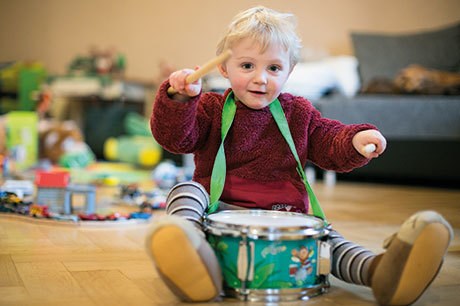
ABOUT THIS SERIES
This eight-part series will explore how music:
aids early learning and development
can support learning across all areas of the EYFS
promotes the Characteristics of Effective Learning.
The series will also identify ways in which adults who lack confidence in their own musical ability or competence can become more confident.
For the first six articles in the series, see www.nurseryworld.co.uk
MORE INFORMATION
www.lmsmusicsupplies.co.uk/folk-and-world
www.tts-group.co.uk/primary/music
www.musichouseforchildren.com/instruments
Books:
Let’s Go Zudie-oand Let’s Go Shoolie-ShoobyHelen MacGregor and Bobbie Gargrave (A&C Black)
The Little Book of Junk Music bySimon MacDonald (Featherstone)


